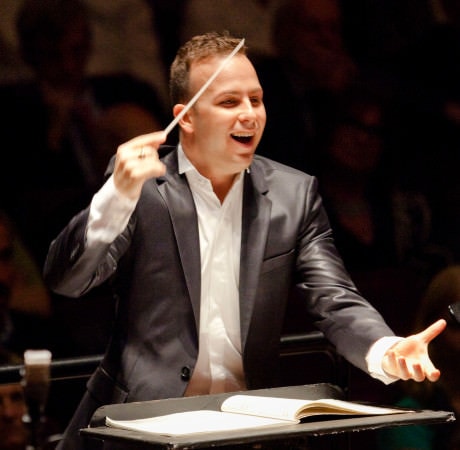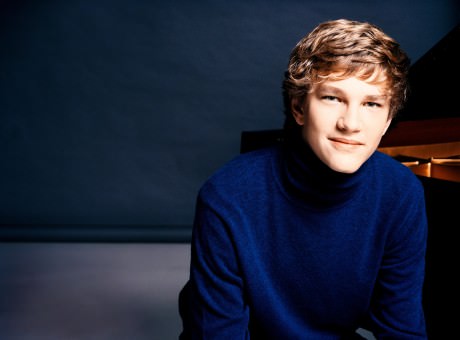Subtext abounded as the Philadelphia Orchestra arrived at The Kennedy Center Tuesday night. In Washington, rising politicians are “mentioned for president.” In classical music, rising conductors are “mentioned for conductor of the New York Philharmonic.” Both positions have openings in 2017.

And the Philadelphia Orchestra’s Montreal-born music director, Yannick Nézet-Séguin, has been “mentioned” as a long shot for the New York Philharmonic’s conductor’s spot at the end of Alan Gilbert’s contract in two years.
Based on last night’s performance, I’d give Mr. Nézet-Séguin the New York job straightaway. Heck, I’d put him on television like Leonard Bernstein in the 1960s and secure the future of classical music in America.
Mr. Nézet-Séguin’s brilliant conducting of Sergei Rachmaninoff’s Symphony No. 2 and Edvard Grieg’s Piano Concerto in A minor just about set the Concert Hall on fire. Mr. Nézet-Séguin has one of the most acute senses of tempo of any conductor I’ve seen and heard in years. He can turn a symphony orchestra on a dime – sometimes at the start of a new passage but sometimes right in the middle of a musical phrase.
Rachmaninoff’s hour-long Second Symphony – the longest of his three and longer than his piano concertos – combines sweeping melodies with march-like themes traversing complicated harmonies. It’s all introduced with a slow, unifying motto at the top of the first movement that by the fourth and final movement is re-employed to grab onto fragments of the first three movements to build to a triumphant ending.
It’s a notoriously difficult symphony to “shape” without leaving the listener feeling it could have been edited down. Mr. Nézet-Séguin rode right past these challenges. He has a way of building a phrase and then, sometimes literally within the middle of a measure, clicking into a new gear. His entire orchestra seems to be attached to his baton. The sense of surprise held throughout the symphony made the hour pass enjoyably and seamlessly.
By keeping both the orchestra and the audience on its toes, Mr. Nézet-Séguin also avoided a modern-day trap of Rachmaninoff’s Second Symphony – the sense that you’re marking time waiting for the “good stuff” to come. The theme of the third movement is the same as the 1976 hit by pop crooner Eric Carmen, “Never Gonna Fall in Love Again.” Of course Rachmaninoff thought of the music first! But later in the third movement, Rachmaninoff reworks the theme – sometimes in the orchestra as a whole and sometimes in solos by clarinets, violins and others – into unfamiliar variants for modern ears.
Mr. Nézet-Séguin’s repeated reaching into his orchestra for counter-melodies set against the pop theme, often with his trademark “goosing” of the tempo at each of these moments, kept interest high and the audience rapt whether the music of the moment was familiar or not.

Mr. Nézet-Séguin’s ability to hit new gears in the music also served him particularly well in the Grieg piano concerto, given that he and the orchestra had to keep up with soloist Jan Lisiecki, another Canadian who is a true prodigy at age 20. Mr. Lisiecki has the ability to roar through Grieg’s occasional torrents of notes, including the familiar opening of the concerto (one of those classical music themes you’ve heard all your life but didn’t know where it “comes from”), and the orchestra stayed in lockstep with the young pianist.
For readers of DCMetroTheaterArts, the fact that Frank Loesser somewhat sarcastically lifted parts of the first movement, including the opening flourish, for the song “Rosemary” in How to Succeed in Business Without Really Trying (in which the character of Finch more-or-less sincerely declares that he loves the woman he intends to marry, although he may love himself and his own ambitions a little more) just added to the interest.
I’d like to see Mr. Lisiecki develop a little more of a singing tone on the piano in more lyrical passages of the Grieg concerto. He is very tall – his knees just about touch the piano below the keyboard when he is playing – and his fingers approach the keyboard rather vertically. As his career develops, it would be nice to see if he can “pull” melodies out of the piano as more experienced concert pianists do. He does have the ability to demonstrate tremendous dynamic range – when he wants to play rolling, accompanying passages very softly, the contrast with his fortissimos is extraordinary – and so I bet he can pull this off over time.
As for Mr. Nézet-Séguin, who turned 40 last month, he has a reputation among musicians as a particularly enjoyable conductor to play for. In what may be best thing of all about last night’s concert, this sense of joyousness was fully on display.
Even the best of world symphony orchestras often visually present a contrast between their principal section players digging into the music and the back chairs mailing it in. Not in today’s Philadelphia Orchestra. The back chairs of both the first and second violin sections, consisting almost exclusively of young women, visibly played with the same “guts” as those in the front. The front desk of the viola section, Choong-Jin Chang and Kirsten Johnson, looked like they were in love with the music all night long. Principal bass Harold Robinson was amazing to watch – he lifted his bow between phrases exactly like a violinist and entertainingly drew it into the next phrase with great propulsion. The entire brass section of the Philadelphia Orchestra may have been less visible, but its playing is simply spectacular.
Mr. Nézet-Séguin has also introduced the European tradition of true solo “bows” among the orchestra members, each of whom has been trained to smile and do a brief head-bow to the audience when singled out to stand up at the end of a symphony. A wonderful piece of choreography during the final ovation, when the entire orchestra, not just the conductor, turned as one to acknowledge the applause of the patrons behind and above them, was a terrific moment that actually inspired the entire audience to the kind of cheer more often heard in a sports arena than a concert hall.
Oh and the pronunciation of this rising star’s name? Listen to Mr. Nézet-Séguin say it himself at 1:25 of this somewhat comical interview with cellist and would-be classical music comedian Nick Canellakis. The best news would be if Mr. Nézet-Séguin’s career progresses further in a way that the whole country can rip off his name at sight. Thanks to Washington Performing Arts, which brought him and the Philadelphia Orchestra to The Kennedy Center, and to similar efforts around the country, it could actually happen.
Running Time: 2 hours, with one 20-minute intermission.
The Philadelphia Orchestra presented by Washington Performing Arts performed on Tuesday, April 7, 2015 at The Kennedy Center Concert Hall – 2700 F Street NW, in Washington, DC. For future Washington Performing Arts concerts, go to their calendar of events.
LINKS
Jan Lisieki website.
Yannick Nezet-Seguin’s website.
https://youtu.be/Sa9yhnFmXSY
https://youtu.be/_Y_tLuudGGk
https://youtu.be/LJ98ILc_M64




